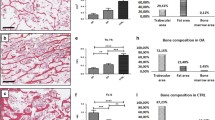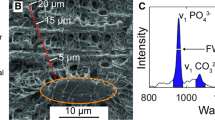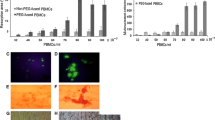Abstract
The etiology of primary osteoporosis in young and middle-aged men is unknown. We have studied osteoblast function in cells derived from men with idiopathic osteoporosis and in control cells from age-matched men with osteoarthrosis. Osteoblasts were isolated from transiliac bone biopsies. Osteoblast function was measured as vitamin D-stimulated osteocalcin production and production of cytokines and factors involved in osteoclast activation and bone formation. Cell proliferation was measured as 3H-thymidine incorporation. Parathyroid hormone-related peptide (PTHrP) mRNA was measured using reverse-transcriptase polymerase chain reaction. In osteoporotic men, bone mineral density at the femoral neck was correlated to in vitro production of osteocalcin. Osteoblasts from osteoporotic men produced significantly less osteocalcin after vitamin D stimulation but had increased production of macrophage colony-stimulating factor (M-CSF) compared to controls. The osteocalcin response was negatively correlated to production of M-CSF, interleukin-6, and C-terminal propeptide of type I collagen. Basal 3H-thymidine incorporation was similar in cells from osteoporotic patients and controls. PTHrP (10−9 M) significantly increased cell proliferation in control cells but not in osteoporotic cells. Basal PTHrP mRNA levels were significantly higher in osteoporotic cells than in cells from controls. The results are in agreement with previous histomorphologic studies indicating that men with idiopathic osteoporosis have an osteoblast dysfunction with decreased osteocalcin production and increased production of factors stimulating osteoclast activation. This indicates a catabolic cellular metabolic balance leading to negative bone turnover, resulting in osteoporosis. The cause of such cellular dysfunction needs further evaluation.







Similar content being viewed by others
References
Chavassieux P, Meunier PJ (2001) Histomorphometric approach of bone loss in men. Calcif Tissue Int 69:209–213
Khosla S, Melton JL III, Atkinson AT, O´Fallon WM, Klee GG, Riggs LB (1988) Relationship between serum sex steroid levels and bone turnover markers with bone mineral density in men and women: a key role for bioavailable estrogen. J Clin Endocrinol Metab 83:2266–2274
Resch H, Pietschmann P, Woloszczuk W, Krexner E, Bernecker P, Willvonseder R (1992) Bone mass and biochemical parameters of bone metabolism in men with spinal osteoporosis. Eur J Clin Invest 22:542–545
Pietschmann P, Kudlacek S, Grisar J, Spitzauer S, Woloszczuk W, Willvonseder R, Peterlik M (2001) Bone turnover markers and sex hormones in men with idiopathic osteoporosis. Eur J Clin Invest 31:444–451
Byers RJ, Hoyland JA, Braidman IP (2001) Osteoporosis in men: a cellular endocrine perspective of an increasingly common clinical problem. J Endocrinol 168:353–362
Szuluc P, Munoz F, Claustrat B, Garnero P, Marchand F, Duboeuf F, Delmas PD (2001) Bioavailable estradiol may be an important determinant of osteoporosis in men: the MINOS study. J Clin Endocrinol Metab 86:192–199
Gillberg P, Johansson AG, Ljunghall S (1999) Decreased estradiol levels and free androgen index and elevated sex hormone-binding globulin levels in male idiopathic osteoporosis. Calcif Tissue Int 64:209–213
Carlsen CG, Soerensen TH, Eriksen EF (2000) Prevalence of low serum estradiol levels in male osteoporosis. Osteoporosis Int 11:697–701
Braidman I, Baris C, Wood L, Selby P, Adams J, Freemont A, Hoyland J (2000) Preliminary evidence for impaired estrogen receptor α-protein expression in osteoblasts and osteocytes from men with idiopathic osteoporosis. Bone 26:423–427
Ongphiphadhanakul B, Rajatanavin R, Chanprasertyothin S, Piaseu N, Chailurkit L (1998) Serum oestradiol and oestrogen receptor gene polymorphism are associated with bone mineral density independently of serum testosterone in normal males. Clin Endocrinol 49:803–809
Ioannidis JP, Stavrou I, Trikalinos TA, Zois C, Brandi ML, Genari L, Albagha O, Ralston SH, Tsatsoulis A (2002) Association of polymorphisms of the estrogen receptor alpha gene with bone mineral density and fracture risk in women: a meta-analysis. J Bone Miner Res 17:2048–2060
Shearman AM, Karasik D, Gruenthal KM, Demissie S, Cupples A, Housman DE, Kiel DP (2004) Estrogen receptor β polymorphisms are associated with bone mass in women and men: the Framingham study. J Bone Miner Res 19:773–781
Bord S, Ireland DC, Beavan SR, Compston JE (2003) The effects of estrogen on osteoprotegerin, RANKL and estrogen receptor expression in human osteoblasts. Bone 32:136–141
Chen FP, Lee N, Wang KC, Soong YK, Huang KE (2002) Effect of estrogen and 1α,25(OH)2-vitamin D3 on the activity and growth of human osteoblast-like cells in vitro. Fertil Steril 77:1038–1043
Liel Y, Kraus S, Levy J, Shany S (1992) Evidence that estrogens modulate activity and increase the number of 1,25-dihydroxyvitamin D receptors in osteoblast-like cells (ROS17/2,8). Endocrinology 130:2597–2601
Duque G, Abdaimi KE, Macoritto M, Miller MM, Kremer R (2002) Estrogens (E2) regulate expression and response of 1,25-dihydroxyvitamin D3 receptors in bone cells: changes with aging and hormone deprivation. Biochem Biophys Res Commun 299:446–454
Johansson AG, Eriksen EF, Lindh E, Langdahl B, Blum WF, Lindahl A, Ljunggren O, Ljunghall S (1997) Reduced serum levels of the growth hormone dependent insulin-like growth factor binding protein and a negative bone balance at the level of individual remodeling units in idiopathic osteoporosis in men. J Clin Endocrinol Metab 82:2795–2798
Kurland ES, Rosen CJ, Cosman F, McMahon D, Chan F, Shane E, Lindsay R, Dempster D, Bilezikian JP (1997) Insulin-like growth factor-I in men with idiopathic osteoporosis. J Clin Endocrinol Metab 82:2799–2805
Lagumdzija A, Oh G, Petersson M, Bucht E, Gonon A, Pernow Y (2004) Inhibited anabolic effect of insulin-like growth factor-I on stromal bone marrow cells in endothelial nitric oxide synthase-knockout mice. Acta Physiol Scand 182:29–35
Lian JB, Stein GS, Aubin JE (2003) Bone formation: maturation and function activities of osteoblast linage cells. In: Primer on the metabolic bone diseases and disorders of mineral metabolism, 5th ed., ASBMR, Washington, DC, pp 13–28
Marie PJ, Sabbagh A, de Vernejoul MC, Lomri A (1989) Osteocalcin and deoxyribonucleic acid synthesis in vitro and histomorphometric indices of bone formation in postmenopausal osteoporosis. J Clin Endocrinol Metab 69:272–279
Marie PJ, Hott M, Launay JM, Graulet AM, Gueris J (1993) In vitro production of cytokines by bone-surface-derived osteoblastic cells in normal and osteoporotic postmenopausal women: relationship with cell proliferation. J Clin Endocrinol Metab 77:824–830
Marie PJ, de Vernejoul MC, Connes D, Hott M (1991) Decreased DNA synthesis by cultured osteoblastic cells in eugonadal osteoporostic men with defective bone formation. J Clin Invest 88:1167–1172
Bang P, Eriksson U, Sara V, Wivall IL, Hall K (1991) Comparison of acid ethanol extraction and acid gel filtration prior to IGF-1 and IGF-2 radioimmunoassays: improvement of determination in acid ethanol extracts by the use of truncated IGF-I as radioligand. Acta Endocrinol (Copenh) 124:620–629
Hilding A, Hall K, Wivall-Helleryd IL, Sääf M, Melin AL, Thoren M (1999) Serum levels of insulin-like growth factor-I in 152 patients with growth hormone deficiency, aged 19–82 years, in relation to those in healthy subjects. J Clin Endocrinol Metab 84:2013–2019
Povoa G, Roovete A, Hall K (1984) Cross reaction of somatomedin-binding protein a radioimmunoassay developed for somatomedin binding protein isolated from human amniotic fluid. Acta Endocrinol (Copenh) 107:563–570
Rong H, Hong J, Pernow Y, Sjöstedt U, Bucht E (1997) Quantitation of parathyroid hormone-related protein mRNA by competitive PCR using time-resolved lanthanide fluorometry. Clin Chem 43:2268–2273
Tsai JA, Rong H, Torring O, Matsushita H, Bucht E (2000) Interleukin-1β?upregulates PTHrP-mRNA expression and protein production and decreases TGF-β in normal human osteoblast-like cells. Calcif Tissue Int 66:363–369
Mundy GR, Chen D, Oyajobi BO (2003) Bone remodeling. In: Primer on the metabolic bone diseases and disorders of mineral metabolism, 5th ed., ASBMR, Washington, DC, pp 46–58
Gyda M, Corisdeo S, Zaidi M, Troen BR (2001) Macrophage colony stimulating factor suppresses osteoblast formation. Biochem Biophys Res Commun 285:328–334
Katzburg S, Lieberherr M, Ornoy A, Klein BY, Hendel D, Somjen D (1999) Isolation and hormonal responsiveness of primary cultures of human bone-derived cells: gender and age differences. Bone 25:667–673
Martinez P, Moreno I, de Miguel F, Vila V, Esbrit P, Martinez ME (2001) Changes in osteocalcin response to 1,25-dihydroxyvitamin D3 stimulation and basal vitamin D receptor expression in human osteoblastic cells according to donor age and skeletal origin. Bone 29:35–41
Karaplis AC, Goltzman D (2000) Parathyroid hormone and parathyroid hormone-related peptide effects on the skeleton. Rev Endocr Metab Disord 1:331–341
Naves M, Alvarez-Hernandez D, Fernandez-Martin JL, Paz-Jimenez J, Garcia Prado P, Fernandex-Coto T, Santamaria I, Cannata-Andia J (2003) Effect of VDR gene polymorphisms on osteocalcin secretion in calcitriol-stimulated human osteoblasts. Kidney Int Suppl 85:23–27
Van Pottelbergh I, Goemaere S, de Barquer D, de Paepe A, Kaufman M (2002) Vitamin D receptor gene allelic variants, bone density and bone turnover in community-dwelling men. Bone 31:631–637
Gomez-Garcia L, Esbrit P, Carrena L, Sabando P, Garcia-Flores M, Martinez ME (2003) Alendronate interacts with the inhibitory effect of 1,25(OH)2D3 on parathyroid hormone-related protein expression in human osteoblastic cells. J Bone Miner Res 18:78–87
Acknowledgments
This study was supported by grants from the Novo Nordic Foundation, Karolinska Institute, Magn Bergwall Foundation, and Stiftelsen Gamla Tjänarinnor. We thank Associate Professor Elisabeth Bucht for the measurement of PTHrP mRNA. We thank Dr. Tycho Tullberg (Stockholm Spine Center) for support and help in finding young control patients.
Author information
Authors and Affiliations
Corresponding author
Rights and permissions
About this article
Cite this article
Pernow, Y., Granberg, B., Sääf, M. et al. Osteoblast Dysfunction in Male Idiopathic Osteoporosis. Calcif Tissue Int 78, 90–97 (2006). https://doi.org/10.1007/s00223-005-0158-9
Received:
Accepted:
Published:
Issue Date:
DOI: https://doi.org/10.1007/s00223-005-0158-9




